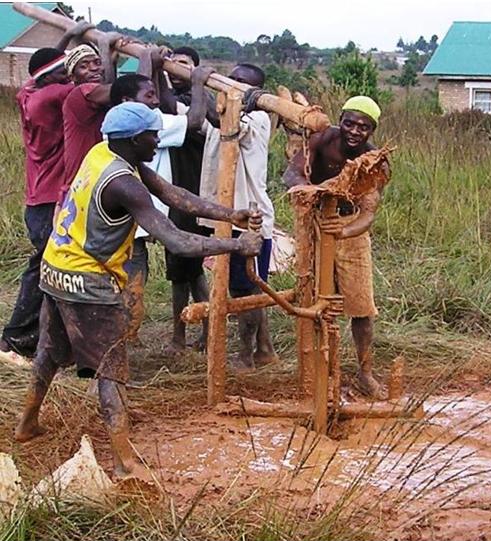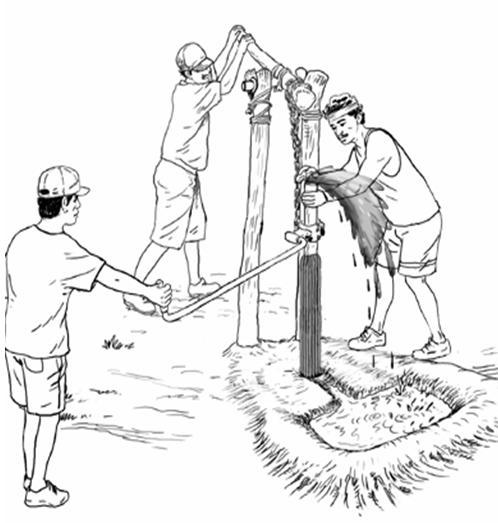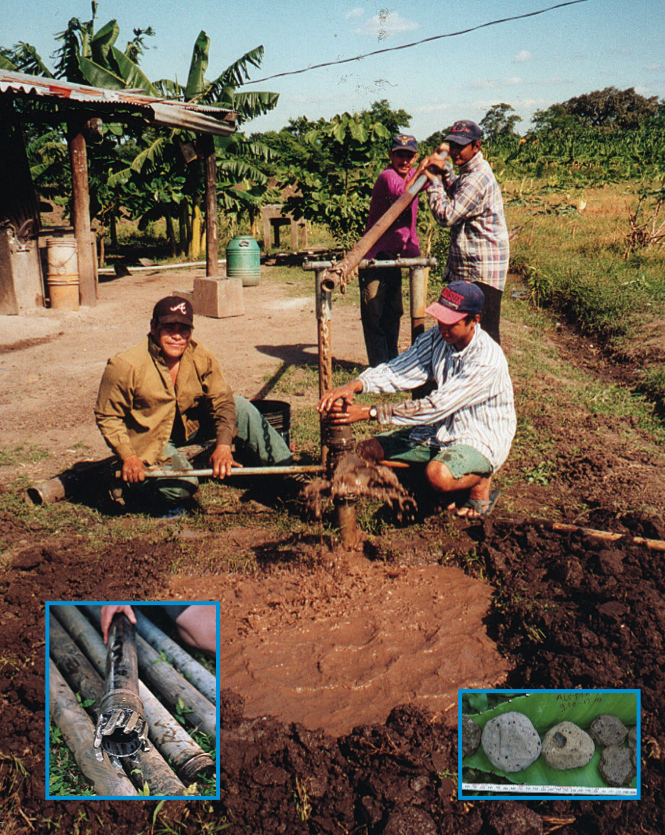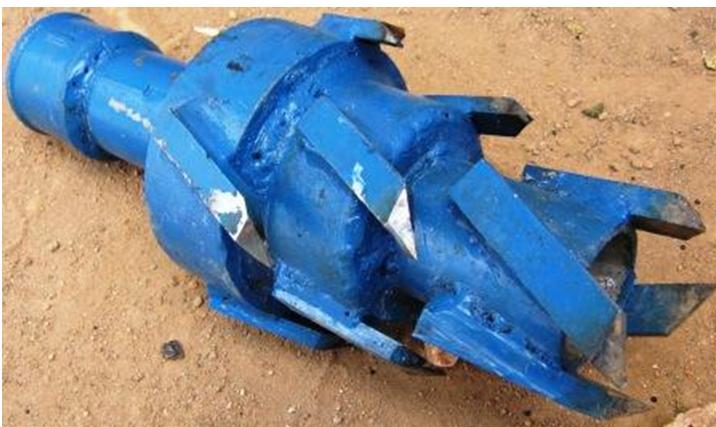Difference between revisions of "Sludging - Rota sludge"
| (40 intermediate revisions by 3 users not shown) | |||
| Line 1: | Line 1: | ||
| − | {{ | + | {{Language-box|english_link= Sludging - Rota sludge | french_link= Coming soon | spanish_link= Coming soon | hindi_link= Coming soon | malayalam_link= Coming soon | tamil_link= Coming soon | swahili_link=coming soon | korean_link= Coming soon | chinese_link=污泥鑽 - 羅塔污泥鑽 | indonesian_link= Coming soon | japanese_link= Coming soon }} |
| − | |||
| − | + | [[Image:Icon_sludge.png|right|80px]] | |
| + | [[Image:Rota sludge in action.jpg|thumb|right|200px|Rota sludge in action]] | ||
| + | [[Image:Deep drilling with the rota sludge.jpg|thumb|right|200px|Deep drilling with the rota sludge]] | ||
| − | The Rota-sludge | + | The Rota Sludge is a manual drilling technique based on the [[Sludging - Asian sludge |Asian sludge]] technique, and adapted for harder soil types. To drill through the harder layers, a hardened drill bit and weight have been added. Just after the downward movement of the drill pipes the drill bit is rotated a quarter turn, thus chiselling the bottom of the hole. Water is circulated to bring the cuttings to the surface. |
| − | + | During drilling, the drill pipe is moved up and down. On the down stroke, the impact of the drill bit loosens the soil and on the up stroke, the top of the pipe is closed by hand (or a valve), drawing up the water through the pipe and transporting the cuttings to the surface. On the next down stroke, the hand (or valve) opens the top of the pipe and the water squirts into a pit, in front of the well. In this pit, the cuttings separate from the water and settle out, while the water overflows from the pit back into the well. | |
| + | The borehole stays open by water pressure. Thickeners such as clay, bentonite or even cow dung are usually added to the water in order to prevent hole collapse and reduce loss of working water (drill fluid). | ||
| − | + | The Rota-Sludge was developed by the [http://www.practica.org Practica Foundation]. | |
| − | - | ||
| − | |||
| − | |||
| − | == | + | ===Suitable conditions=== |
| + | Suitable for unconsolidated formations: Sand, silt and clay. Because of the rotation and the drill bit, it is possible to penetrate softer-consolidated formations such as stiff clays, soft sandstone, and weathered laterite. | ||
| − | 2-5 inch wells to 20 | + | The Rota Sludge method can be used to drill 2-5 inch wells up to 20 m deep. |
| − | == | + | {| border="1" cellpadding="5" cellspacing="0" align="none" |
| + | |- | ||
| + | ! width="50%" style="background:#efefef;" | Advantages | ||
| + | ! style="background:#f0f8ff;" | Disadvantages | ||
| + | |- | ||
| + | | valign="top" | - Easy to handle and a temporary casing is normally not needed. It is possible to construct the drilling equipment locally.<br> | ||
| + | - Can drill through softer-consolidated formations. | ||
| + | | valign="top" | - The borehole stays open by water pressure. To prevent collapsing, fluid-drilled boreholes must be kept full of water during the entire drilling and well installation process.<br> | ||
| + | - Coarse gravel and other highly permeable materials (cracks in the formation) cause loss of working water and cannot be drilled. If very fine sands (quick sands) are encountered in the first three meter of the borehole, a temporary casing and swell clay are needed on the outside of this casing to prevent collapse.<br> | ||
| + | - If cow dung is used as drilling fluid, this can cause contamination of the well, which can take several weeks to disappear. | ||
| + | |} | ||
| − | + | ===Construction, operations and maintenance=== | |
| − | + | [[Image:Diagram of a rota sludge.jpg|thumb|right|200px|Diagram of a rota sludge]] | |
| + | [[Image:Rota_sludge_well_drilling.PNG|thumb|right|200px|Drilling a 20 m deep well in Chinandega, Nicaragua, with the Rota-sludge method. Photo: Netherlands Water Partnership.]] | ||
| + | [[Image:Rota sludge drill bit.jpg|thumb|right|200px|Rota sludge drill bit]] | ||
| − | + | Cow dung is mixed with water to create a very low cost drilling fluid. It may take several weeks after the drilling is finished for the pathogens (bacteria) to die and disappear completely out of the well. | |
| − | |||
| − | + | All drilling equipment is locally produced. | |
| − | == | + | ===Costs=== |
| + | In India, the cost of a well made with Rota-sludge is about US$ 30. In Nicaragua, this varies from US$ 80 to US$ 400. | ||
| − | + | The cost of introduction varies between US$ 5,000-20,000 per project, including hand-on training, drill set and drilling of test wells. | |
| − | |||
| − | == | + | ===Field experiences=== |
| + | The Rota Sludge is used in Nicaragua, Tanzania, Madagascar, Ghana, Senegal, Mauritania and Niger. | ||
| − | * [http:// | + | ===Manuals, videos and links=== |
| − | + | *[http://ec.europa.eu/echo/files/evaluation/watsan2005/annex_files/PRACTICA/PRACT2%20-%20Rota-sludge%20and%20stone%20hammer%20drilling.pdf Rota-sludge and stone hammer drilling, Part 1, Drilling manual]. Produced by [http://www.practica.org PRACTICA Foundation] and [http://www.etc-international.org/index.php?id=41 ETC Foundation]. | |
| − | + | *[http://www.sswm.info/sites/default/files/reference_attachments/HERWIJNEN%202005%20Rota%20Sludge%20and%20Stone%20Hammer%20Drilling%20Part%20two%20Production%20Manual.pdf Rota-sludge and stone hammer drilling, Part 2, Production manual]. Produced by [http://www.practica.org PRACTICA Foundation] and [http://www.etc-international.org/index.php?id=41 ETC Foundation]. | |
| − | * [http://www. | + | |
| − | * | + | * [http://www.practica.org/products/drilling-wells/ Drilling & Wells], Practica Foundation. |
| − | + | ||
| − | * | + | |
| + | {{#ev:youtube|MvebFHCjCvk|200|auto|<font size="2"><center>Rota sludge drilling in <br>Madagascar, January 2008</center></font>}} | ||
| + | |||
| + | === Acknowledgements=== | ||
| + | * The basis for the material on this page was obtained from a desk study shortly to be published on the website of the [http://www.practica.org Practica Foundation], and from the [http://www.rural-water-supply.net/ Rural Water Supply Network], and specifically its [http://www.rural-water-supply.net/en/implementation/manual-drilling manual drilling section]. | ||
| + | * [http://www.lboro.ac.uk/well/resources/technical-briefs/43-simple-drilling-methods.pdf 43. Simple drilling methods.] WEDC. | ||
Latest revision as of 00:33, 6 September 2016
| |
|
|
|
|
|
|
|
|
|
The Rota Sludge is a manual drilling technique based on the Asian sludge technique, and adapted for harder soil types. To drill through the harder layers, a hardened drill bit and weight have been added. Just after the downward movement of the drill pipes the drill bit is rotated a quarter turn, thus chiselling the bottom of the hole. Water is circulated to bring the cuttings to the surface.
During drilling, the drill pipe is moved up and down. On the down stroke, the impact of the drill bit loosens the soil and on the up stroke, the top of the pipe is closed by hand (or a valve), drawing up the water through the pipe and transporting the cuttings to the surface. On the next down stroke, the hand (or valve) opens the top of the pipe and the water squirts into a pit, in front of the well. In this pit, the cuttings separate from the water and settle out, while the water overflows from the pit back into the well.
The borehole stays open by water pressure. Thickeners such as clay, bentonite or even cow dung are usually added to the water in order to prevent hole collapse and reduce loss of working water (drill fluid).
The Rota-Sludge was developed by the Practica Foundation.
Contents
Suitable conditions
Suitable for unconsolidated formations: Sand, silt and clay. Because of the rotation and the drill bit, it is possible to penetrate softer-consolidated formations such as stiff clays, soft sandstone, and weathered laterite.
The Rota Sludge method can be used to drill 2-5 inch wells up to 20 m deep.
| Advantages | Disadvantages |
|---|---|
| - Easy to handle and a temporary casing is normally not needed. It is possible to construct the drilling equipment locally. - Can drill through softer-consolidated formations. |
- The borehole stays open by water pressure. To prevent collapsing, fluid-drilled boreholes must be kept full of water during the entire drilling and well installation process. - Coarse gravel and other highly permeable materials (cracks in the formation) cause loss of working water and cannot be drilled. If very fine sands (quick sands) are encountered in the first three meter of the borehole, a temporary casing and swell clay are needed on the outside of this casing to prevent collapse. |
Construction, operations and maintenance
Cow dung is mixed with water to create a very low cost drilling fluid. It may take several weeks after the drilling is finished for the pathogens (bacteria) to die and disappear completely out of the well.
All drilling equipment is locally produced.
Costs
In India, the cost of a well made with Rota-sludge is about US$ 30. In Nicaragua, this varies from US$ 80 to US$ 400.
The cost of introduction varies between US$ 5,000-20,000 per project, including hand-on training, drill set and drilling of test wells.
Field experiences
The Rota Sludge is used in Nicaragua, Tanzania, Madagascar, Ghana, Senegal, Mauritania and Niger.
Manuals, videos and links
- Rota-sludge and stone hammer drilling, Part 1, Drilling manual. Produced by PRACTICA Foundation and ETC Foundation.
- Rota-sludge and stone hammer drilling, Part 2, Production manual. Produced by PRACTICA Foundation and ETC Foundation.
- Drilling & Wells, Practica Foundation.
Madagascar, January 2008
Acknowledgements
- The basis for the material on this page was obtained from a desk study shortly to be published on the website of the Practica Foundation, and from the Rural Water Supply Network, and specifically its manual drilling section.
- 43. Simple drilling methods. WEDC.





